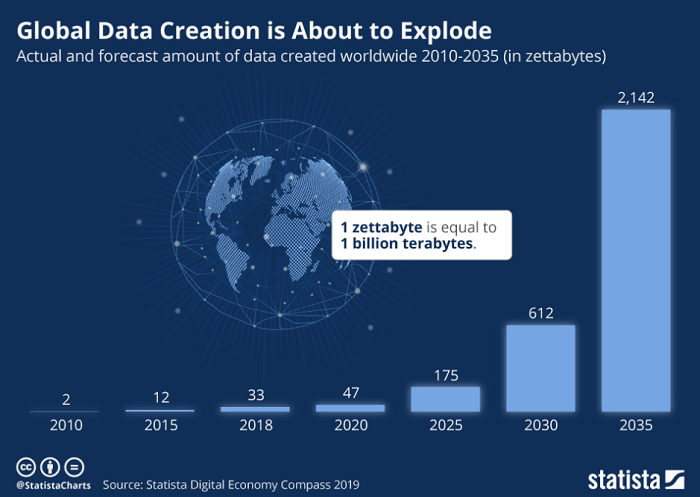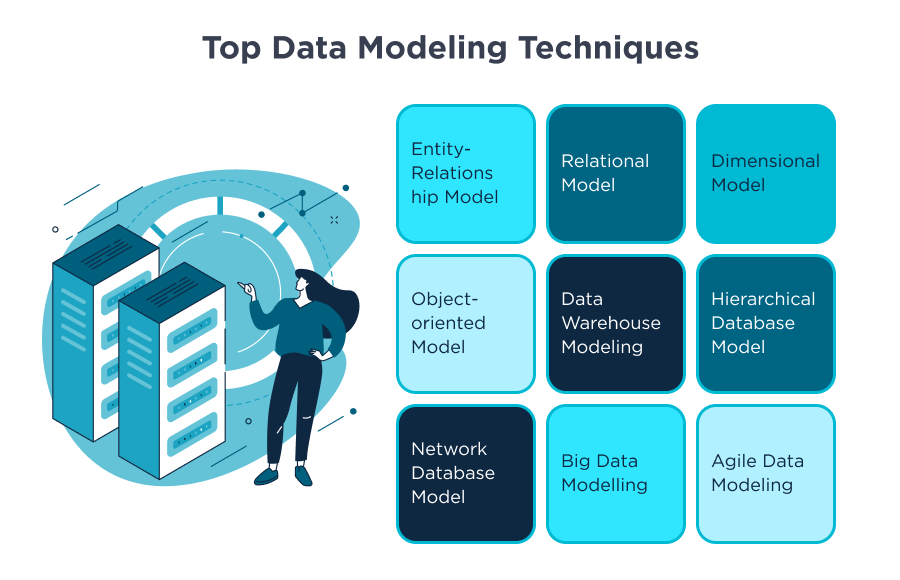Today there are more data sources available to us than ever before, and businesses are not an exception.They deal with vast amounts of data which should be organized effectively to drive valuable insights and streamline operations.
According to Statista, global data creation is projected to grow 612 zettabytes by 2030 and reach 2140 by 2035. With such an expansion, businesses should focus more on data management if they want to enhance processes and gain a competitive edge in the market. And here, a data modeling strategy can serve as a helping hand to harness data effectively.

Data modeling helps companies structure and organize data by designing a visual representation of it. In essence, it lies at the core of data engineering solutions.
In this blog post, we will take a look at the data modeling techniques, as well as discuss the ways how they contribute to efficient data collection, processing, and storage.
What Is Data Modeling?
Data modeling is the process of evaluating and defining different sources and types of data that your company works with. Simply put, it establishes connections between pieces of information and categorizes them into logical groups. That is achieved by creating a visual representation of data with all of its attributes, relationships, and storage locations.
In general, data modeling acts as a well-defined roadmap for data management, helping organizations plan their data architecture more efficiently. On top of that, it supports stakeholders in better decision-making by providing ground for data analytics and facilitating it.
Discover Types of Data Analytics
Concepts of Data Modeling

Now let’s keep diving deeper into the topic and have a look at three main data modeling concepts.
Conceptual: It is typically used at an early stage of the project when we analyze requirements. It provides a high-level overview of what the system will include and how it will be organized.
Logical: This model goes one step further. As the name implies, it helps break data into minor logical elements and build a detailed visual schema of relationships between them. It aids organizations in streamlining approaches for data consolidation and segmentation.
Physical: This one derives from a logical concept and helps describe how data will be structured within a specific database management system. It serves like a guide for data engineers during the visualization and implementation of databases.
Common Data Modeling Techniques

As we’ve already mentioned, when well-structured, a data model serves as a basis for subsequent analysis and informed decision-making. With that in mind, let’s get into the most popular types of data modeling techniques that you can leverage to build an effective data management strategy.
#1 Entity-Relationship (ER) Model
Though introduced in 1976, the entity-relationship data model still remains a thing these days. It illustrates the connections between entities in a database using formal diagrams. They assist in understanding the fundamentals of the information that will be located within the data store.
The ER model contains three main components: entities, attributes, and relationships. Entity symbolizes a real-world entity, such as a person or location, and is displayed on tables. As for attributes, they explain the features of each entity. And the relationship is a connection between two or more entities that can take several forms, such as one-to-one, one-to-many, or many-to-many.
#2 Relational Model
Another technique that was introduced a long time ago is a relational model. It is still widely used in database architecture, connecting data in tables through rows and columns.
It aims to simplify the data and offer a clear perspective, as well as facilitate efficient storage and analysis. Moreover, it utilizes the principles of set theory and predicate logic.
For example, relational databases can help handle massive amounts of essential customer information, monitor stocks, conduct e-commerce transactions, and much more.
#3 Dimensional Model
Dimensional models are mostly used in data warehouse design with the goal to optimize a database for faster retrieval of information. They also help remove redundancy and inconsistencies, thus contributing to better data quality.
These models have numerous benefits, including the capacity to organize data for analysis in a simple, clear, and customizable manner. Furthermore, they enable the quick and easy addition of new data, which can support companies with dynamic business environments.
In a dimensional model, information is divided into two types of tables: fact and dimension. Fact tables are often large and contain millions or billions of rows. For example, they can store data about sales transactions, customer orders, and more.
On the other hand, dimension tables are relatively smaller in size. They contain descriptive information that helps understand data in the context of the business environment.
#4 Data Warehouse Modeling
The next technique in our list is data warehouse modeling. It is the process of building and arranging data models within your data warehouse platform.
Overall, there are 3 types of data warehouse modeling:
Enterprise Warehouse: An enterprise warehouse integrates data from diverse sources, as a result it reduces data silos and ensures accurate and reliable information throughout the organization. Generally, it comprises both extensive and summary information and can range in size from a few gigabytes to hundreds of gigabytes, terabytes, and even more.
Here the warehouse serves as a repository for both structured and unstructured data. It helps enterprise software developers use this data to build various solutions for reporting and analysis.
Learn more about Enterprise Warehouse Benefits
Data Mart: The second type of data warehouse modeling is data mart. In simple words, it is a portion of corporate-wide data that is useful to a certain group of users. Overall, it focuses on an exact industry, department, or a particular business area.
Take, for instance, marketing data. It can contain data entities such as customers, items, campaigns, sales, and website analytics.
Virtual Warehouse: The third one is a virtual warehouse. It is a cloud-based storage and processing environment where organizations can store, manage, and analyze their data without the need for physical infrastructure. Virtual warehouse takes data management a step further by promoting agility, scalability, and cost-effectiveness.
How to Build a Cloud Data Management Strategy
#5 Object-Oriented Model
Another technique of data modeling is called object-oriented, where data is stored in the form of objects. This model is based on the object-oriented programming approach and involves designing data models that mirror real-world objects and their relationships. Each object has its own set of attributes and behaviors, or methods.
For example, let’s consider a data model for an educational system. In this case, you might have classes like student, teacher, course, and department. Students then could have attributes such as ID, name, major, and a list of enrolled courses. And courses could have attributes like course ID, title, department, and a list of enrolled students, etc.
The object-oriented model is flexible and adaptable since it allows for quick model modification and enhancement as requirements change. Thus you can benefit from it when you need, let’s say, to add new object types without changing the old ones.
#6 Hierarchical Database Model
This approach organizes data in the form of a tree, maintaining a parent-child relationship within records. A parent can have more than one child, while a child record is limited to having only one parent.
Hierarchical model helps maintain data consistency since changes to a parent record are automatically transmitted to its children. Furthermore, by limiting access to certain levels of the hierarchy, you can gain comprehensive control over data.
#7 Network Database Model
The network model is an expanded version of the hierarchical one. It enables a child record to have one or more parents. When compared to the hierarchical approach, it allows for more flexible data access.
By incorporating the network model technique into the data modeling process, you may capture the intricate relationships and interactions between various data points, enhancing the accuracy of the overall data model.
#8 Big Data Modeling
When it comes to analyzing big data, it’s quite challenging to implement it using the traditional methods due to large volumes of data. In order to manage this process smoothly, you can leverage big data modeling.
This technique is tailored to handle the unique characteristics of big data, such as volume, velocity, variety, and variability. By using visual models, like diagrams, charts, and graphs, you can easily generate insights from massive and complicated datasets.
Big data modeling is often empowered by machine learning and artificial intelligence technologies that help businesses comprehend and evaluate vast amounts of data. AI and ML can be used for many purposes such as automated data collection, making predictions, deriving insights, and so on.
#9 Agile Data Modeling
Last but not least, is agile data modeling. As the name suggests, it combines agile software development approaches, like the Agile Manifesto and Scrum, with the process of data modeling. It aims to develop database architectures that are flexible and responsive to changes in the requirements.
In general, by using this approach, it is possible to refine the data model based on the feedback from end users and evolving business needs. This dynamic method enables your development team to quickly adapt the data model and incorporate new elements.
Learn about the Common Mistakes to Avoid When Practicing Agile Approach
Leverage Data Modeling for Better Decision-Making
Today we have discussed top data modeling methodologies and how they are used to drive efficient data engineering and management strategies.
By employing the aforementioned techniques in the right way, you can reap all of their benefits. However, it can be challenging to determine which ones suit your business most and implement them successfully.
If you are not sure what type of data modeling to leverage in accordance with your business needs, our team of data engineers is here to assist you. Don’t hesitate to reach out to us for help.









